User-generated content (UGC) has become increasingly important over the past few years.
In fact, in a recent HubSpot survey of 500+ marketers who sell content via social shopping features, 92% say user-generated content increases brand awareness of their products.
And, as Emplifi’s Chief Strategy Officer Kyle Wong told me, “User-generated content is a 24/7, 365-day marketing channel and opportunity.”
Here, we’ll dive into 10 examples of impressive UGC campaigns to inspire your own campaigns. Plus, hear Wong’s five tips for taking your UGC strategy to the next level.
Keep reading, or skip to:
Examples of user-generated campaigns
Kyle Wong’s 5 tips for creating your own UGC campaign
10 Examples of Excellent User Generated Campaigns
1. Sephora
Cosmetics powerhouse Sephora describes its on-site Beauty Insider Community as “your one-stop destination to share beauty advice, inspiration, news, and recommendations with real people in real time.”
In addition to text threads and groups that users can interact with, Sephora’s Community Gallery features UGC from real customers in an aesthetically-pleasing, interactive design.
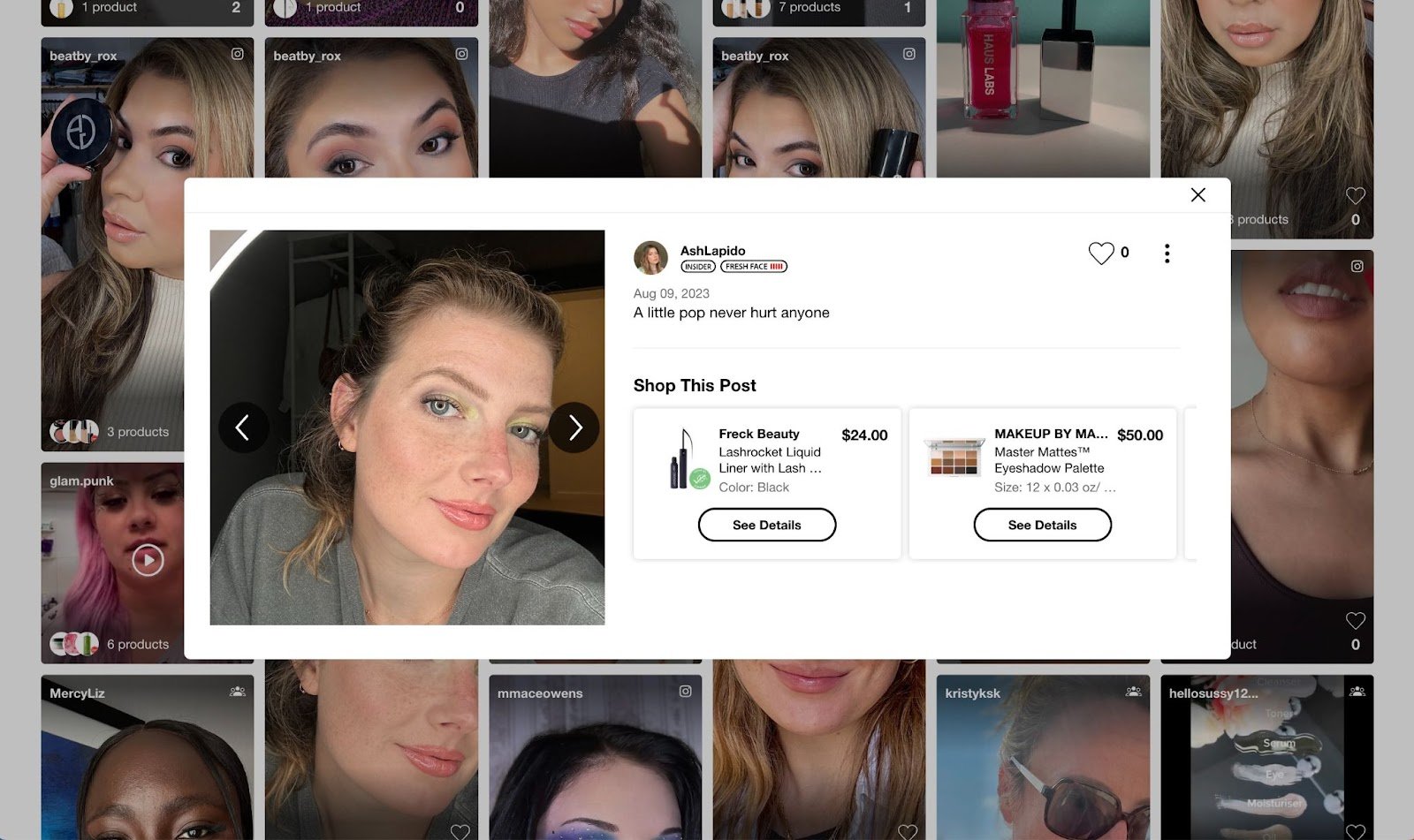
Sephora sources this content from social media and direct uploads, and UGC is made shoppable so site visitors can easily explore products featured in pictures from community members.
The gallery automatically updates as new UGC is approved, demonstrating Sephora’s dedication to its customers while driving conversion and product discovery.
2. Farrow & Ball
Manufacturer Farrow & Ball is known for its bold wallpapers, paints, and creative product names — as well as a knack for inspiring its customers. With several active displays of UGC across the brand’s blog posts, product pages, and other site pages, Farrow & Ball celebrates its talented community while showcasing ideas for up-and-coming interior designers and everyday shoppers alike. A dedicated community gallery also allows visitors to filter UGC by color, room, style, and product type.

Farrow & Ball boasts an impressive, engaged community of 1.6 million followers on Instagram, and UGC makes up the majority of the brand’s posts.
3. The Cosmopolitan of Las Vegas
The Cosmopolitan of Las Vegas is one of the most Instagrammed hotels in the world, and doesn’t pass up the chance to proudly showcase its guests’ impressive photos.
The Cosmopolitan features dazzling UGC on category pages for its different offerings, from restaurant shots to casino moments. Blending influencer content with UGC on the hotel’s Instagram has ultimately driven over 250 million impressions, engaging followers and contributing to site traffic.
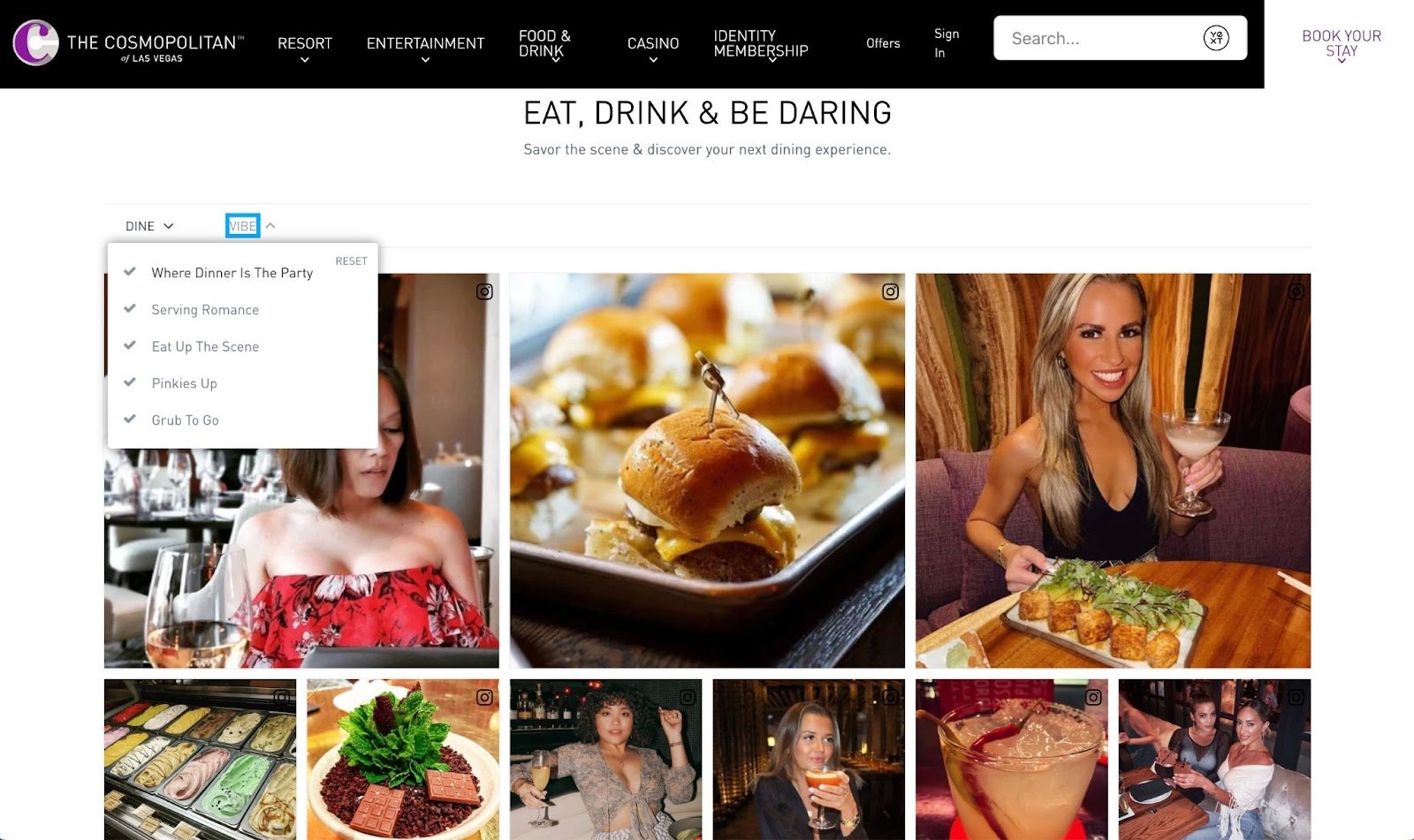
4. Article
Article is an online-only furniture brand known for creating chic, Scandinavian-inspired modern pieces. Selling directly to customers, Article lacks conventional showrooms that allow customers to visualize products in real life.
That’s where UGC comes in: Article gives its customers a plethora of authentic images showing how people style the brand’s furniture in their spaces.
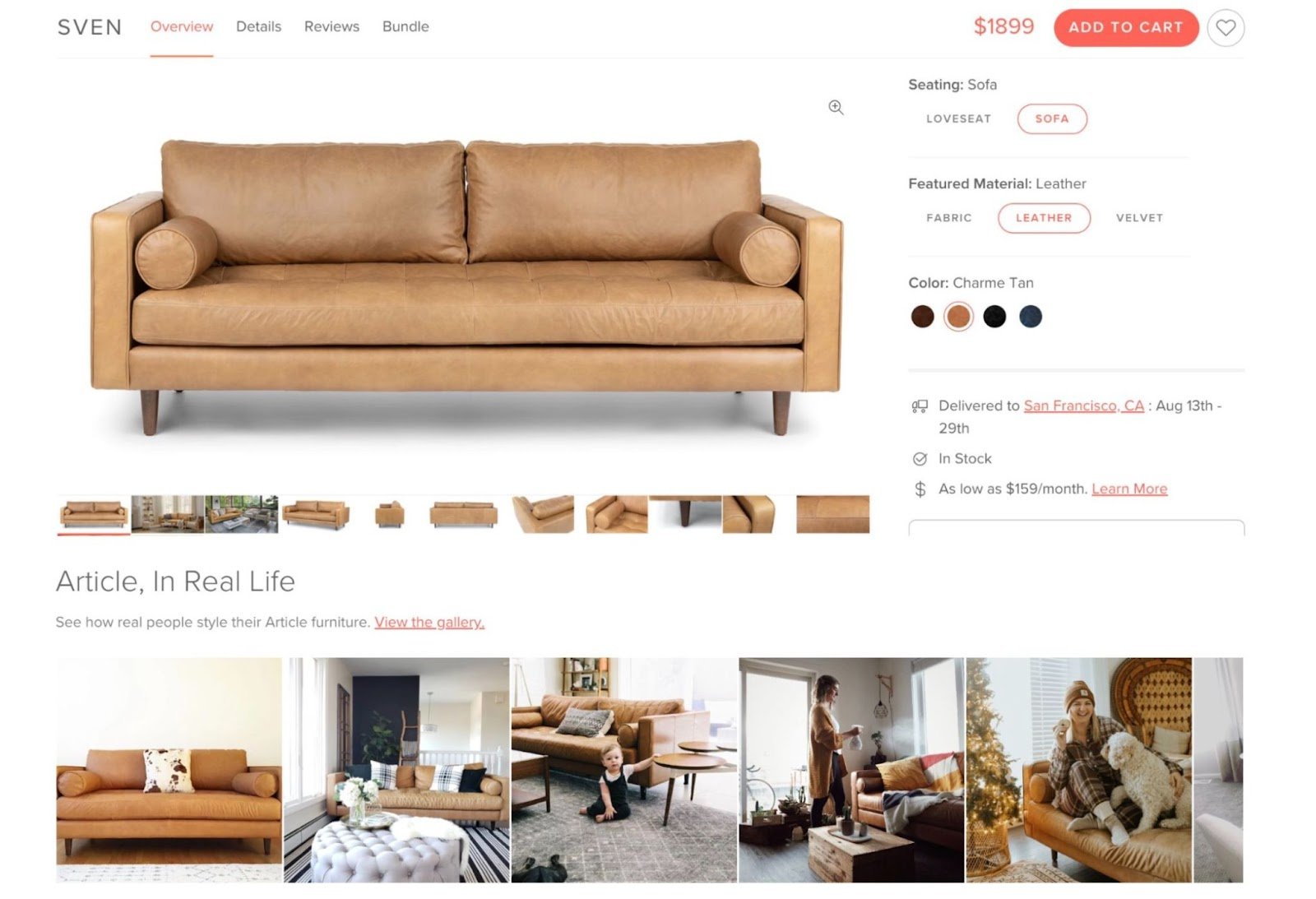
Article displays real customer photos and furniture pairing recommendations on product pages to increase time on site and lower bounce rates, in addition to a shoppable inspiration gallery of UGC.
5. Vitamix
Vitamix offers its customers a wide selection of juicers, blenders, and other food processors, and takes a creative approach to engaging its culinary community. In addition to sharing recipes and UGC on Instagram, Vitamix ran a “Smoothie of the Year” contest asking fans to vote for nutrient-dense “nourish” smoothies or Instagram-worthy “flourish” smoothies.
The two opposing teams were led by nutrition influencers, and Vitamix spotlights nourish and flourish UGC carousels on the contest’s landing page.
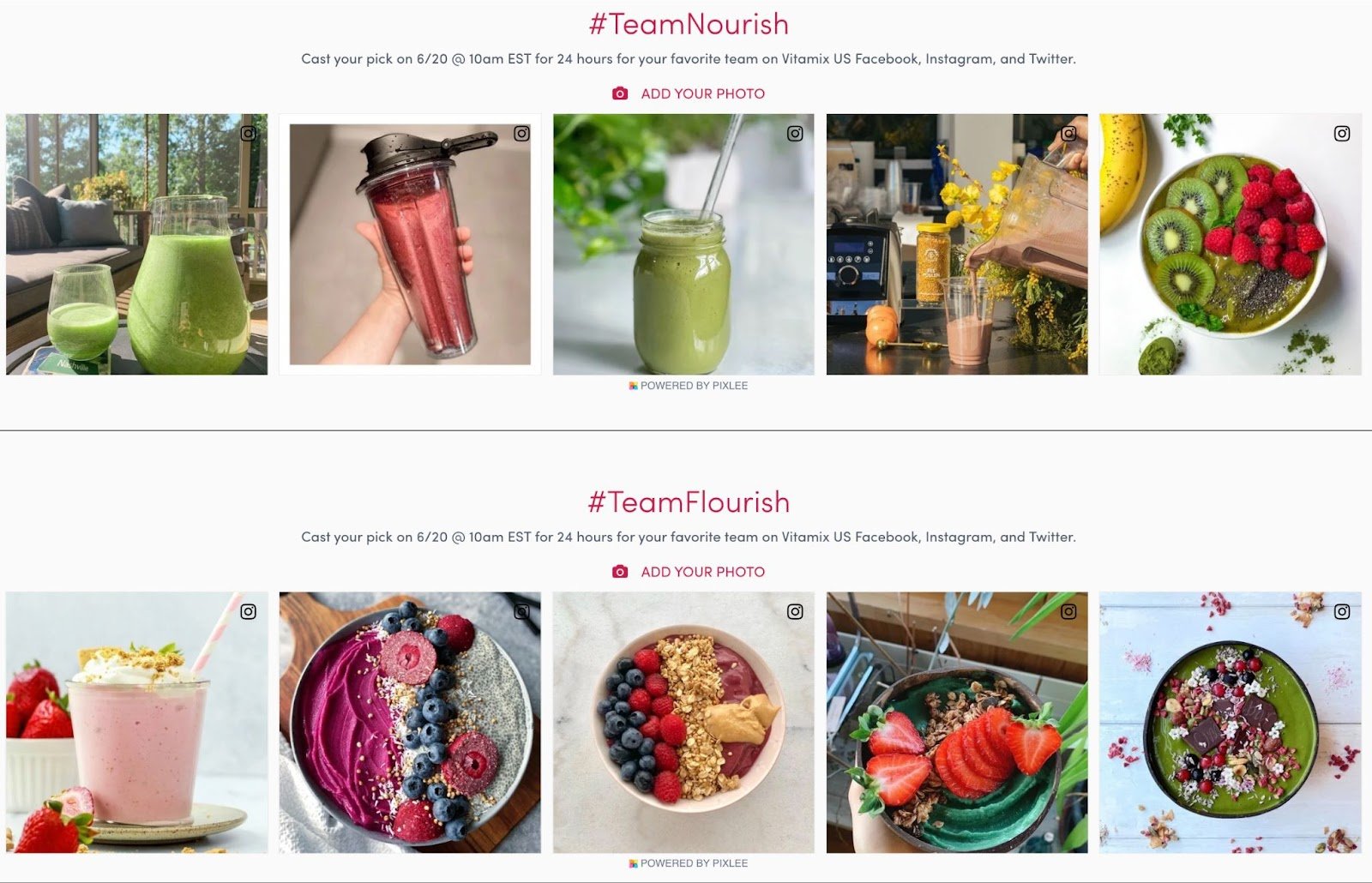
6. Crocs
Iconic brand Crocs is one of the biggest names in footwear, catering to shoppers of all ages and giving customers the opportunity to customize their looks with diverse Jibbitz shoe gems.
To celebrate its global community and showcase how they style their Crocs, the brand invites customers to share UGC on social media with the trendy hashtag #MyCrocsEra.

As a brand with an already established userbase, Crocs skillfully adds an element of community to its on-site and social content strategy, boosting customer retention and purchase confidence.
7. Revel Nail
Revel Nail increases their conversion rate and reduces product page abandonment while adding a splash of fun to its marketing strategy with colorful, gorgeous UGC across the brand’s digital channels.
In addition to displaying customer photos on product pages, social media, and an on-site photo gallery, Revel Nail features shoppable TikTok videos from customers showing how they create stunning nail designs with the brand’s products.

8. Jones Soda
Beverage brand Jones Soda boasts one of the most unique approaches to UGC, allowing fans to submit UGC via Instagram or direct upload for the chance to have their photo featured on a physical bottle label. Site visitors can vote on submissions through an interactive UGC gallery.
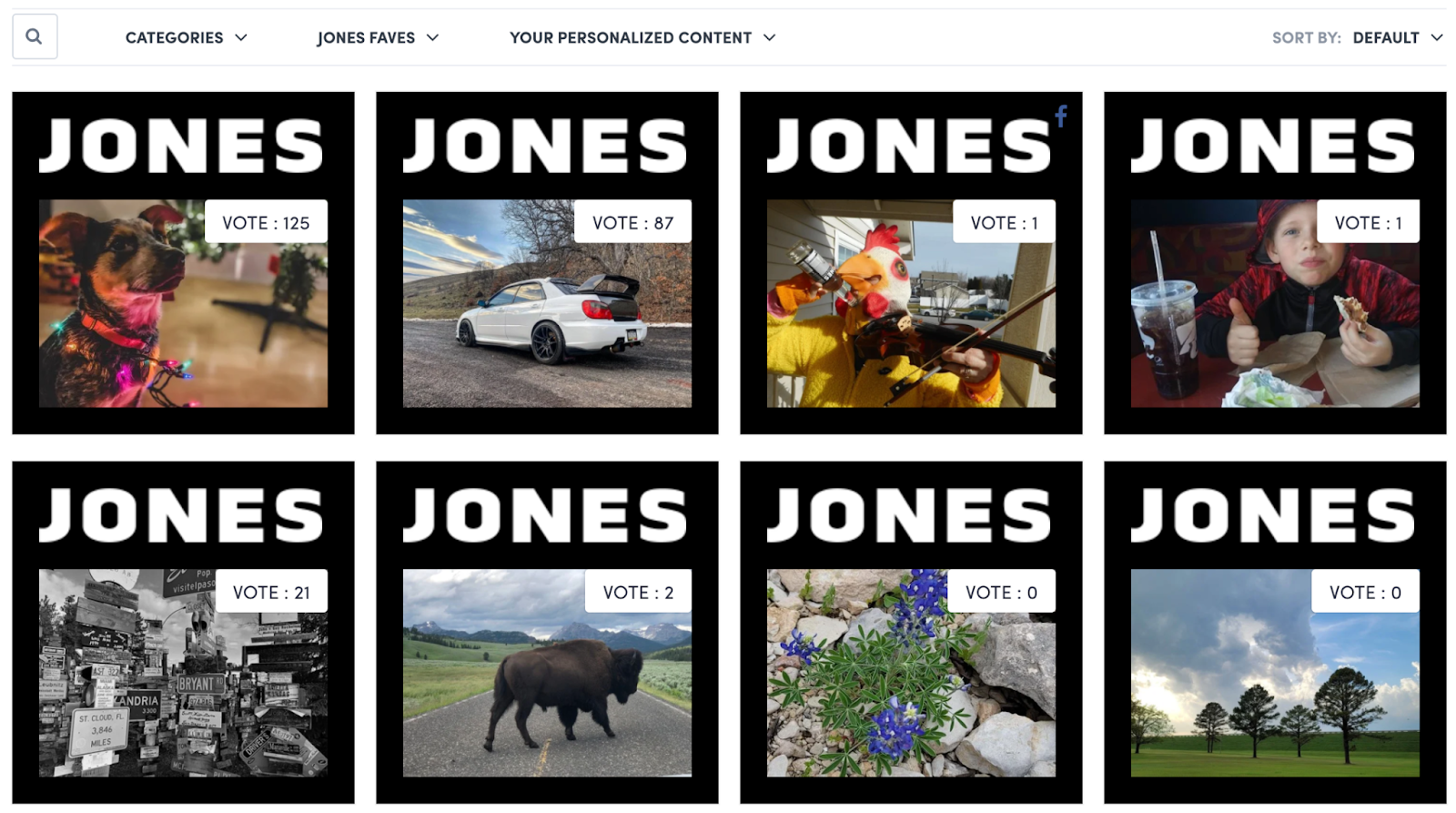
In 2021, Jones Soda took this opportunity to a new level with its Reels Label campaign, encouraging social users to share Instagram Reels to potentially be printed on soda bottles and viewable via augmented reality (AR) with the brand’s app.
9. Northumbria University
Universities and other educational institutions may not come to mind when you think about user-generated content. However, Northumbria University in England embraces its students and faculty through various creative, on-site displays of UGC.
For one, Northumbria promotes an #IAmNorthumbria community gallery, which illustrates university life through community photos. Additionally, Northumbria’s Newcastle Business School even spotlights UGC from real students on course and masters pages to give site visitors a look at a day-in-the-life of students.
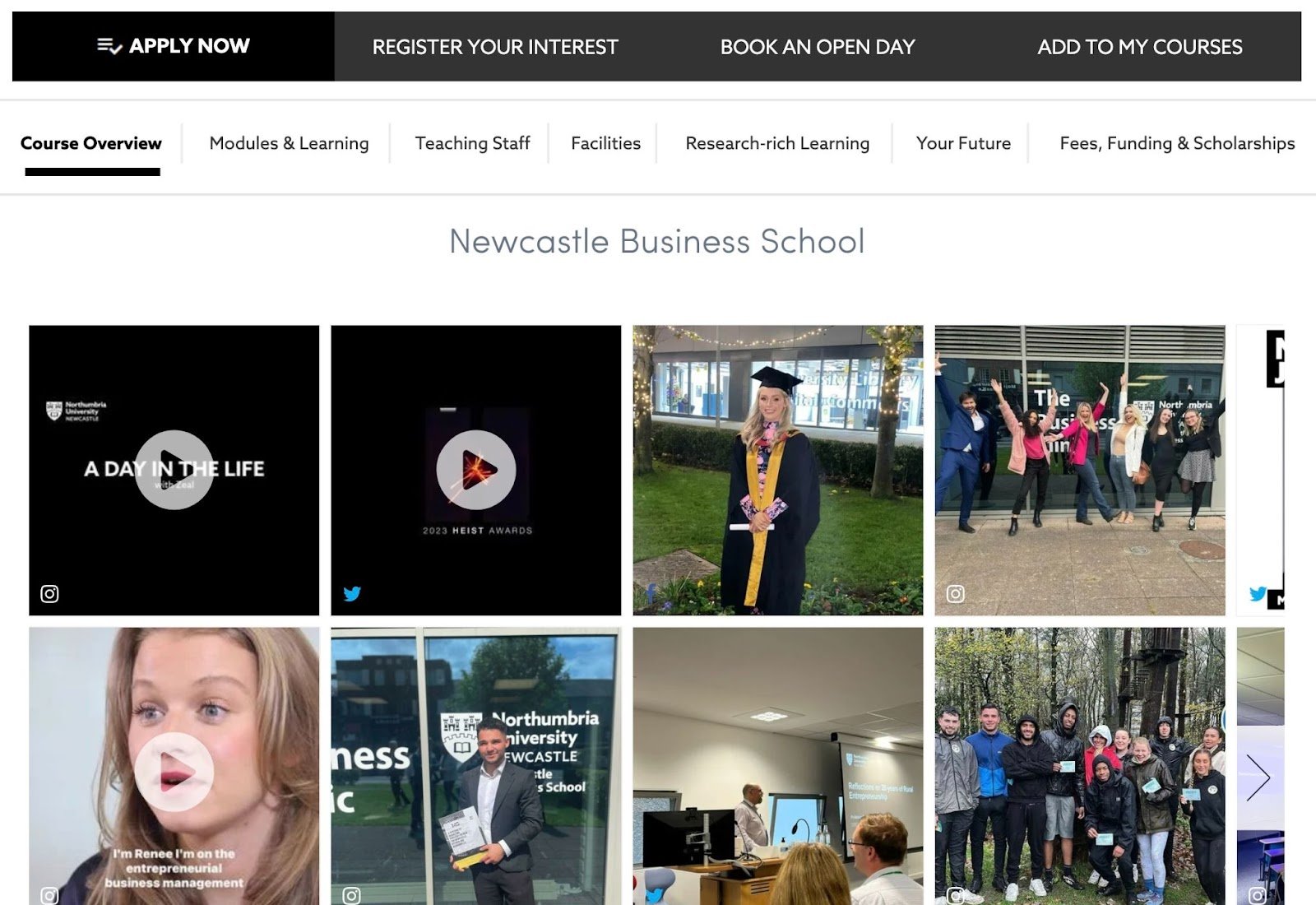
10. NAVY Hair Care
Last but certainly not least, NAVY Hair Care is a spectacular leader when it comes to sharing and celebrating the authentic experiences of its customers — through visual UGC, detailed ratings and reviews, and more.
Founded in 2018 on social-forward values, NAVY Hair Care drove a 264% increase in repeat-visit rate and website engagement upon championing UGC on social and website pages. Combining customer visuals with reviews adds an additional level of social proof for the brand, showing customers what it’s really like to use their products.

How to Run Your Own User-Generated Content Campaign, According to Emplifi’s Chief Strategy Officer
When I spoke with Kyle Wong, he began by highlighting the importance of user-generated content for small and big businesses alike.
As he puts it, “Every company has three branches of marketing: Earned, paid, and owned. And one aspect of earned media is PR, but the other part is from your customers, which has traditionally been mostly word-of-mouth marketing.”
Wong adds, “The biggest shift that’s happened over the past couple of years is word-of-mouth marketing from your happy customers has become infinitely more scalable.”
He continues, “So when investing in a strategy around user-generated content, it’s important to understand the basics, which is this: We are investing in a strategy to essentially help capture more positive word-of-mouth marketing from our customers.”
Your customers are already providing positive feedback of your products — whether that’s through customer support phone calls, product review pages, or via social channels. A user-generated campaign, then, is critical for simply amplifying the messages already being shared by your customers.
Let’s launch into Wong’s five steps for creating a strong campaign now.
1. Create a repository for your customers’ positive stories — and offer diverse options for customers’ to leave reviews.
There are plenty of customer stories already being shared about your brand. These stories might be in a written format, photo format, video format, or audio format. And there are innumerable places to find these stories: Review sites, customer support messages, social media channels, email, post-product reviews, and more.
Wong told me: “If people are posting good stories about your brand, the first question you need to ask is: ‘What are we going to do with it? Are we going to do nothing, or leverage it to grow our business?’ Step one is collecting that content, and encouraging more of it.”
You’ll want to figure out a process for collecting and storing positive stories for your marketing team to leverage in future UGC campaigns.
As Wong puts it, “I don’t think a lot of brands have a good repository for all of that content. There needs to be a central library for those customer stories. Our platform does a lot of that, but even if you don’t use us, there should be a central library somewhere.”
Additionally, Wong encourages business owners to create as many opportunities for positive feedback as possible. For instance, you might:
- Create feedback forms
- Have a positive story section of your website
- Create testimonial pages
- Ensure you’re active on all major social channels
This makes it easy for customers to share their positive reviews where, when, and how they’d prefer.
As you design your promotion for a UGC campaign, consider the types of “entries” that you’ll accept. Pictures, videos, or testimonials are all powerful content types that can be easily converted for advertising purposes.
2. Figure out where the right place(s) are to amplify this content.
Now you have a repository — great. What’s next?
You’ll want to figure out how you’re going to amplify these messages. One major opportunity to share UGC is via social media channels. At the bare minimum, you might retweet or repost someone else’s content. You could also share the post to your Instagram Stories, and have a dedicated UGC Stories collection saved on your profile.
But you can also create a landing page to showcase customers’ content, or create a section on your product pages or homepage. These sections will allow your site visitors to see how other consumers are using your products, which is undeniably helpful as they consider purchasing your product.
There are major benefits to featuring user-generated content on your website. Wong told me, “We’ve found that user-generated content performs better than traditional stock imagery when it comes to conversion rates. There’s a couple of reasons for this. One is, of course, the authenticity element.”
“But two,” He adds, “Is that it’s virtually impossible to replicate the variety of the content that you get from your community because you get the product used in so many different variations, different forms, and different places. Sure, a photographer could get you the same quantity of images — but they couldn’t come up with the same variety of images as your customers can.”
Simply put, variety helps sell your product. Once I see the different ways customers are already using your solution, I am more likely to understand how it can solve a problem in my life, as well.
3. Have a call-to-action for your customers.
Wong suggests having a call-to-action for your customers when they post user-generated content.
For instance, you might create a specific hashtag for the campaign, or ensure they tag you so the content is affiliated with your brand. Alternatively, maybe you ask them to fill out a form for a chance to be featured in your campaign.
CTAs allow you to display all user-generated content in one place. A hashtag, for instance, allows users’ to see all related posts when they click on the hashtag.
Wong points out that there’s a major advantage to this: As more people see your brand sharing user-generated content, they naturally begin to share more, as well.
He says, “I’ve seen that happen across every single company we work with. The more a company features their customers — whether it’s on the website or through social — the more everybody else begins to share more about that company.”
He adds, “A lot of the brands who have grown quickly, especially in the SMB space, are typically strong on social and strong with their community efforts.”
4. Use UGC content to inform product lines or marketing positioning.
It’s important to call-out the bigger ramifications of listening to your customers’ positive reviews.
Positive reviews can inform your product strategy just as much as negative ones.
Wong told me, “User-generated content is a strong vantage point on what people are doing with your brand, and what they’re already happy about. And I’ve found it can be a source of inspiration for many business owners. The ‘user’ in user-generated campaigns can help you with rebranding, product lines, market positioning, and more.”
Ultimately, you’ll want to leverage your user-generated campaigns to make decisions when it comes to how you build and market your product moving forward.
5. Straighten out any legal issues.
If you’re conducting a giveaway as part of your campaign, you’d be wise to consult legal counsel on two important issues: the rights you’ll hold over any content submitted to your promotion, and any restrictions that govern giveaways.
First, you need to inform participants about what will happen to the content they create following submission in clear, easy-to-understand language.
But also, if your state or municipality (or the mediums through which you run the contest) control how, when, and under what circumstances giveaways can occur, you’ll want to be sure your promotion is in compliance before running afoul of the law.
Given the breadth of the different industries highlighted above, it’s clear that any brand can follow a similar model to promote customer engagement and generate favorable publicity.
![]()

![Download Now: The Ultimate Guide to User-Generated Content [Free Ebook]](https://i4lead.com/wp-content/uploads/2023/11/82ab0972-f6ed-48ed-b0bc-e5e8ea32dc34.png)
